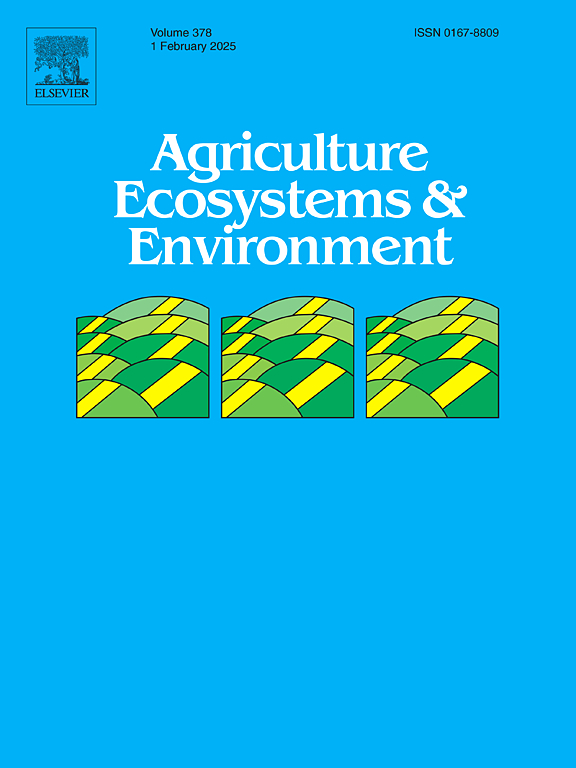Optimizing soybean production and emission reduction through biogas slurry substitution and straw incorporation: A five-year field study in northeast China's black soil region
IF 6
1区 农林科学
Q1 AGRICULTURE, MULTIDISCIPLINARY
引用次数: 0
Abstract
To address the dual challenges of enhancing soybean yield and mitigating greenhouse gas (GHG) emissions in sustainable agriculture, this five-year field study (2020–2024) in Northeast China's black soil region evaluated the synergistic effects of biogas slurry substitution (0–100 % nitrogen replacement) and straw incorporation methods (deep ploughing vs. surface covering) on soil carbon-nitrogen dynamics, GHG emissions, and agronomic performance. Results demonstrated that a 75 % biogas slurry substitution (R3) combined with deep ploughing maximized soybean yield (4.24–18.36 % increase over conventional nitrogen fertilization) while significantly improving soil organic carbon (SOC, +10.52–25.72 %), dissolved organic carbon (DOC, +1.36–5.58 %), and nitrogen availability (NO3--N: +11.47–25.27 %; NH4+-N: +10.04–22.74 %). Crucially, deep ploughing with R3 reduced GHG emissions by 4.29–18.63 % (CO2, N2O, CH4), global warming potential (GWP) by 8.96–17.63 %, and emission intensity (GHGI) by 9.26–16.29 % compared to surface covering. Structural equation modeling revealed that elevated SOC and NO3--N mediated the trade-off between yield enhancement and emission reduction. These findings highlight that integrating 75 % biogas slurry substitution with deep straw incorporation optimizes the carbon-nitrogen cycle, achieving synergistic yield growth (13.31 % maximum), carbon sequestration (SOC, +25.72 %), and GHG mitigation (CH4, −18.63 %), providing a transformative strategy for climate-resilient soybean production in temperate agroecosystems.
沼液替代与秸秆还田优化大豆生产与减排——东北黑土区5年田间研究
为了解决可持续农业中提高大豆产量和减少温室气体排放的双重挑战,本研究(2020-2024)在东北黑土地区进行了为期五年的实地研究,评估了沼液替代(0-100 %氮替代)和秸秆还田方式(深耕vs地表覆盖)对土壤碳氮动态、温室气体排放和农艺学性能的协同效应。结果表明:75% %沼液替代(R3)配合深耕,大豆产量最高(比常规施氮增加4.24 ~ 18.36 %),土壤有机碳(SOC, +10.52 ~ 25.72 %)、溶解有机碳(DOC, +1.36 ~ 5.58 %)和氮素有效性(NO3—N: +11.47 ~ 25.27 %;NH4 + - n: + 10.04 - -22.74 %)。重要的是,与地表覆盖相比,深耕R3减少了4.29-18.63 %的温室气体排放(CO2, N2O, CH4),全球变暖潜势(GWP) 8.96-17.63 %,排放强度(GHGI) 9.26-16.29 %。结构方程模型表明,有机碳和NO3—N的升高介导了产量增加和排放减少之间的权衡。这些研究结果表明,将75% %的沼液替代与深层秸秆结合可以优化碳氮循环,实现协同增产(最大13.31 %)、固碳(SOC, +25.72 %)和温室气体减缓(CH4, - 18.63 %),为温带农业生态系统中气候适应性大豆生产提供了一种变革策略。
本文章由计算机程序翻译,如有差异,请以英文原文为准。
求助全文
约1分钟内获得全文
求助全文
来源期刊

Agriculture, Ecosystems & Environment
环境科学-环境科学
CiteScore
11.70
自引率
9.10%
发文量
392
审稿时长
26 days
期刊介绍:
Agriculture, Ecosystems and Environment publishes scientific articles dealing with the interface between agroecosystems and the natural environment, specifically how agriculture influences the environment and how changes in that environment impact agroecosystems. Preference is given to papers from experimental and observational research at the field, system or landscape level, from studies that enhance our understanding of processes using data-based biophysical modelling, and papers that bridge scientific disciplines and integrate knowledge. All papers should be placed in an international or wide comparative context.
 求助内容:
求助内容: 应助结果提醒方式:
应助结果提醒方式:


